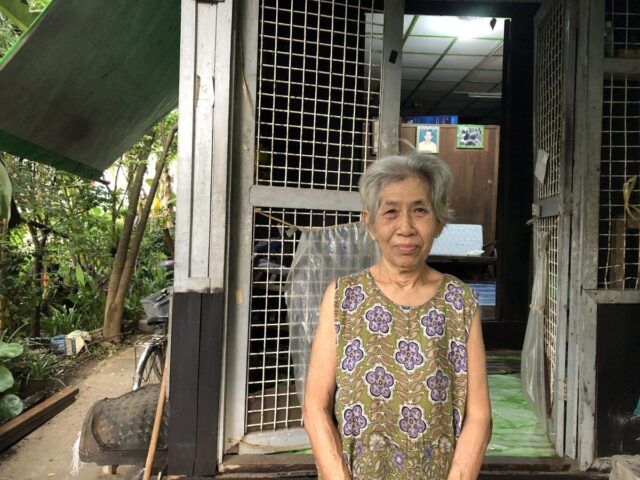Her home in the Thaketa township, located east from central and downtown Yangon, is the part of Yangon city, the furthest away from the water reservoirs. Most people in Thaketa, like Daw Khin Aye Kyu, do not have water from the tap.
She has been collecting rainwater for drinking purpose and domestic use since she was born. “In my origin place, we harvested rainwater, so it has been common to do for my entire life,” she says. In 1970, she moved to Yangon from the delta region of the Ayeyarwady River.
The motive of rainwater harvesting “To be honest, I would rather trust the quality of water coming from the rain than from the ground. It has become my instinct,” she shares her motive for collecting rainwater. “I use rainwater for everything: cooking, showering, flushing, washing dishes and also for drinking. Also, I use rainwater to water my plants,” she says as she shows her garden alongside her house, which has many trees and plants, such as a banana tree, drumstick tree and tamarind.
We are joined by U Soe Ya, the 33-year-old son of Saw Khin Aye Kyu. He says: “I was told that rainwater becomes acidic these days and it is not good for human health, but for me, I have been drinking it since I was a child. But how about the water from the ground? It may become more alkaline, which could harm your kidneys, right?”
According to the data from the Department of Meteorology and Hydrology, the PH value of rainwater in Yangon has been mostly within the standards of the World Health Organization since over a year. (Ref. Here).
Working hard Paid Off
To collect clean rainwater, Daw Khin Aye Kyu has to plan ahead. Before the rain comes, she cleans the roof and gutters. Then she waits for the rain to clear out the dust and vegetation. “After raining three times, we can start using the rainwater, not only for showering but also for drinking,” she says. Five family members of hers consume rainwater from May to October when it is the rainy season, which supplies enough for all daily purposes without worrying about water.
The average duration of Monsoon season is from around May to October, so to work hard and plan for the future like the prudent ants from Aesop’s fable, Daw Khin Aye Kyu conserves rainwater in the water storage tanks. “If we save it in time, we don’t have to be concerned about water shortage during summer, when the heat is intense,” she added.
Containment, storage tanks for storing rainwater and gutter at Daw Khin Aye Kyu’s house. (Photo – Kaung Myat Oo)
“Because we collect the rainwater, we rarely use our motor to pump groundwater, so it is saving energy and electric bills for us. Purchase of drinking water bottles is also not needed,” U Soe Ya explained that he has been saving up thanks to the rainwater.
“As we drink rainwater for six months and don’t have to buy water bottles, we reserve around 900,000 kyats per year (623 USD approx.),” he proudly mentioned that he receives the complimentary gift from nature every year.
“if it rains for 1 hour, rainwater coming down the roof through the gutter can fill the concrete hollow cylinder which can contain around 1300 litres,” he explains about the water storage. Two cylinders with different heights and a pot which can additionally hold about 150 liters are placed around the house and are ready to harvest rainwater.
Based on different climate data resources climate-data.org and weather-altas.com, the average annual rainfall in Yangon is between 2378 mm or 93.6 inches and 2681 mm or 105.6 inches. Based on the house dimension, Daw Khin Aye Kyu & U Soe Ya’s house roof of 93 square meters with such a rainfall can potentially harvest about 250,000 litres of rainwater (93m2 * 2681mm = 249333L). The most rain falls over 3-4 months of a year in Yangon. (Ref. Calculating the Amount of Rainwater Capturable from Your Roof here.)
Basically, with a conservative 2000mm rainfall, a 100m2 shed would provide 200,000 litres of high-quality rainwater which is equal to ten thousand of 20-liter drinking water jar bottles. Therefore, harvesting rainwater for an individual household can evidently offer an invaluable amount of water.
To be more accurate, a small amount of water will get lost in the gutters, but the number is simply an estimate to give us a good idea of how much rainwater we can harvest.
Other water resources and traditional purposes on rainwater usage
Daw Khin Aye Kyu informs me that most of the people who lives near her place, Thaketa, are common to harvest rainwater for using different purposes. So, I walked around and asked a few neighbors about harvesting rainwater.
We meet U Thant Sin Oo who also lives in Thaketa and collects rainwater for drinking water purposes only. “Here we normally collect rainwater at a larger or smaller scale to mitigate the water scarcity,” he explains.
“We have a lake near our place, and it takes 1 hour to fetch water with the trolley we call Tunn Hle and fill my tank three times,” he shows his tank which has been there since he arrived. The concrete cubical tank can retain approximately 1100 litres based on the dimension he provides. He saves time and energy to get water and he can stay comfortable not worrying about water till December every year, based on his information.
Additionally, U Thant Sin Oo uses rainwater for making tea, an important part of culture in Myanmar, which generally consists of raw tea leaves and water. “I boil the rainwater and serve tea for my guest as well as when I meet up with my relatives or friends at my place,” he mentions.
Other people in the neighbourhood show me how to use rainwater differently. “we use rainwater to throw to our sculpture of Thagyamin nat, (high ranking spirits worshipped in Myanmar, Ed.) every morning, and I don’t use it for other purposes, as we have drinking water bottles and groundwater for domestic purpose,” a person who lives in Thaketa revealed.
Big Changes start with small steps
According to Myanmar Times News, up to 2.4 billion liters of water will have to be distributed to Yangon by 2040 which is more than two times the current supply, based on a master plan jointly drafted by the Japan International Cooperation Agency (JICA) and YCDC in 2010. Two of the ongoing projects, The Kokkowa Water Distribution Project and the Pyin Lagoon Water Distribution Project, will be completed by 2025 and 2022, respectively.
In the meantime, rainwater harvesting is cheap and practical for local communities to strengthen household water availability. Rainwater is an alternative source of water, and helps preserve waterways or simply be more self-sufficient. Similar to the hard-working ants from Aesop’s fables, these people take action towards these practices for reserving their income and prepare for uncertain times ahead.
By KYAW NYUNT LINN | Myanmar Water Portal
Photos by Kaung Myat Oo











